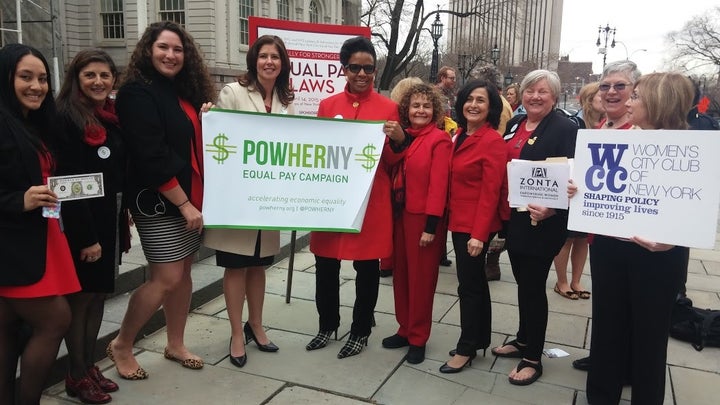According to a recent study by the Pew Research Center, more than half of men in the United States think sexism is over, while nearly two-thirds of women say obstacles continue to make it harder for women than men today.
Consider this glaring example. Despite women outnumbering men at the college and graduate levels, and presumably moving into the types of higher paying jobs that higher education leads to, in the workplace the gender and racial pay gap stubbornly persists.
Even in New York, the state with the narrowest pay gap in the country, overall, women earn only 87.6 percent of what the state’s men earn, according to “The Economic Status of Women in New York State,” an analysis commissioned this past fall by The New York Women’s Foundation in partnership with The Institute for Women’s Policy Research (IWPR). The report estimates that while progressing at the current rate, the same since 1960, the state’s gender and racial wage gap will not close until the year 2049. Overall, it found that women earn less than their male counterparts, are more likely to live in poverty, and are less likely to own businesses. And, there are significant disparities across racial and ethnic groups; with women of color fairing worse than women of other identities.
But if New York’s women were paid the same as comparable men, each would earn $6,600 more per year, an earnings increase that would add $29.6 billion to the state economy. If New York’s working women were paid the same as their male peers—men who are of the same age, have the same level of education, work the same number of hours, and have the same urban/rural status— it would reduce the poverty rate for the state’s women and their families by more than half, from 7.5 to 3.6 percent. For New York families headed by single mothers, the poverty rate would also fall by slightly more than half, from 27.8 to 13.5 percent. This would have the greatest impact on women of color, who are disproportionally affected by the pay discrepancies of low-wage work.
Generational shifts offer a reason for optimism. In New York State―so far, the only one in the nation―millennial women earn more than their male counterparts ($38,319 for women aged 16-34, compared with $37,542 for men of the same ages). The higher earnings of women in this age group, compared with men, may be due in part to their relatively high level of education: 46.6 percent of women aged 25 to 34 in New York hold a bachelor’s degree or higher, compared with 37.2 percent of men in the same age group.

There are other signs of progress, policy changes that will level the gender and racial wage gap playing field due in great measure to the work of advocates such as A Better Balance, the New York Paid Leave Coalition, and PowHer NY.
In 2016, New York City Mayor de Blasio signed an executive order that will eliminate salary history as a requirement when a person applies for a job with the City. This policy change will help break the cycle of wage discrimination and close the wage gap, because salary history is often used a tool for setting wages, and thus can perpetuate the inequitable pay scale that women face with each successive job.
As part of New York State’s 2016-2017 budget approval process, Governor Andrew Cuomo signed two pieces of legislation affecting employers: a minimum wage increase and 12 weeks paid family leave. Statewide, the $15 minimum wage, which has just started to be phased in, will lift the earnings of more than 2.3 million New Yorkers, more than half of whom are women. The paid family leave policy, the most comprehensive in the nation, will help workers maintain financial stability while caring for a new child or sick relative.
On the federal front, the U.S. Equal Employment Opportunity Commission, in cooperation with the Department of Labor, now offers a tool to help root out unlawful pay discrimination by collecting compensation data by gender, race and ethnicity from businesses with 100 or more employees.
Months ago while on the campaign trail, candidate Trump promised to improve conditions for women who work outside the home by implementing guaranteed, paid maternity leave throughout the nation and providing more tax credits for caregivers. Let us hope his presidential actions match his campaign promises in this area. These efforts will be laudable ones if done right, but so much more is needed on the road to pay equity.
On the federal, state and local levels, there must be better enforcement of equal employment opportunity laws; policies that address a lack of work/family supports; improved access to educational opportunities―especially for women of color; career guidance for women on the earnings potential of different fields of study and occupations; and incentives for female entrepreneurs and business owners.
Ultimately, to end the gender and racial wage gap, we must place the same socioeconomic value on the work done by women as the work done by men.
